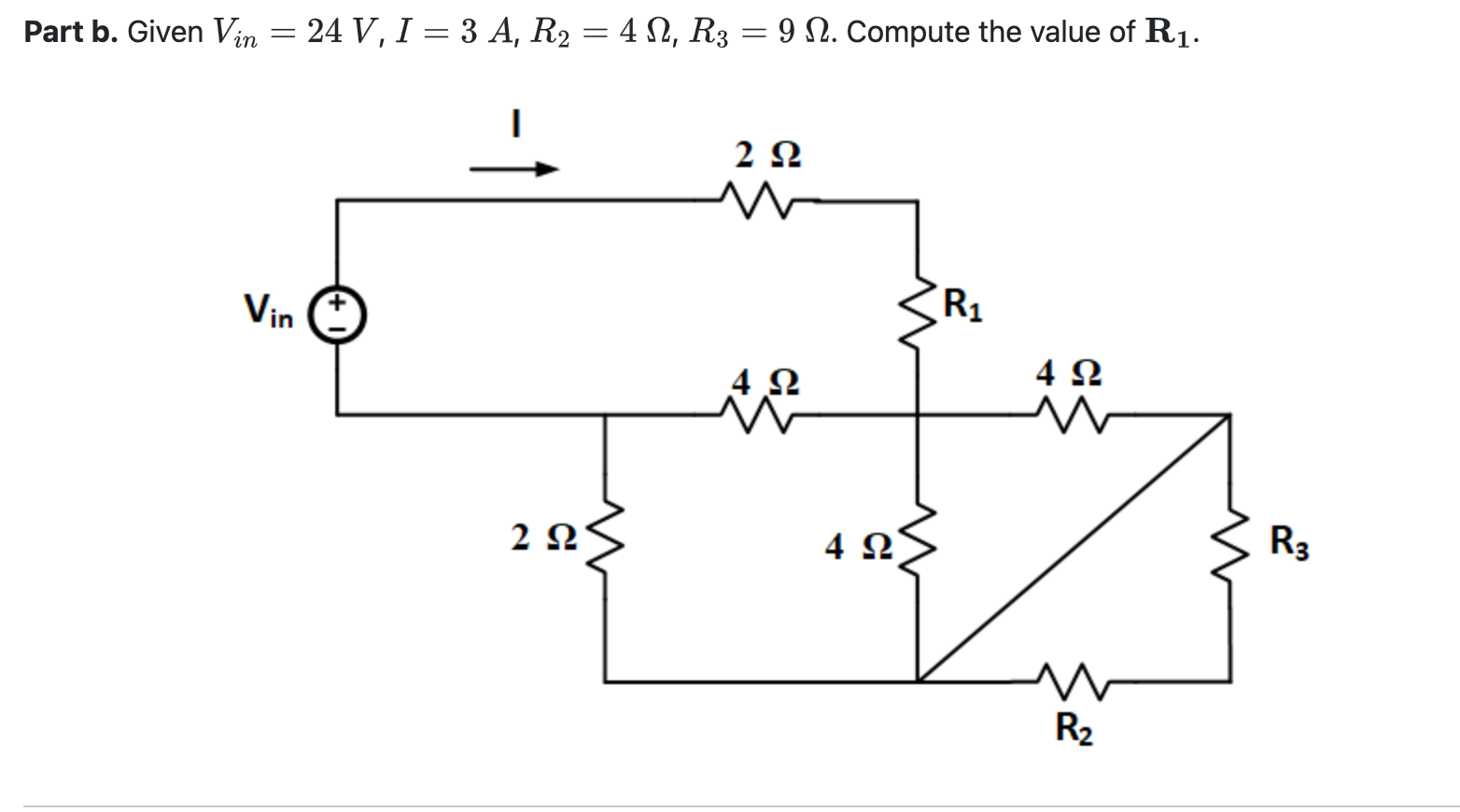Given $V_{in} = 24V$, $I = 3A$, $R_2 = 4\Omega$, $R_3 = 9\Omega$, compute the value of $R_1$ in the circuit.

Understand the Problem
The question asks us to determine the value of resistor $R_1$ in the provided circuit. We are given the input voltage ($V_{in} = 24V$), the total current ($I = 3A$), and the values of resistors $R_2$ and $R_3$ ($R_2 = 4\Omega$, $R_3 = 9\Omega$). To solve this we need to use our knowledge of circuit analysis to find the equivalent resistance.
Answer
$R_1 = -\frac{26}{3} \Omega$
Answer for screen readers
$R_1 = -\frac{26}{3} \Omega \approx -8.67 \Omega$
Steps to Solve
- Simplify the resistor network.
Notice that the $4\Omega$ resistor, $R_2 = 4\Omega$, $R_3 = 9\Omega $ and the remaining $4\Omega$ resistor form a Wheatstone bridge. Since $4\Omega / 4\Omega \ne 4\Omega / 9\Omega$, the bridge is unbalanced, and we sadly can't simplify it to two series resistors in parallel. Also notice that the $4\Omega$ resistor that is in series with the $4\Omega$ resistor that is in parallel with $R_2 = 4\Omega$ does nothing, since it is shorted out. Thus, the effective resistance is zero.
- Redraw the simplified circuit.
After the simplification, we have a $2\Omega$ resistor in series with $R_1$, which is in parallel with the series combination of a $2\Omega$ resistor and $R_3 = 9\Omega$. $R_2 = 4\Omega$ is in parallel with $R_3 = 9 \Omega$. Furthermore, the simplified $4\Omega$ resistor is parallel to $R_2 = 4\Omega$, so they can be combined using the parallel resistor formula.
- Calculate the equivalent resistance of $R_2$ and $4\Omega$
Since they are in parallel, we use the formula for resistors in parallel. Let $R_{2,4}$ be the equivalent resistance. $$ R_{2,4} = \frac{R_2 \cdot 4}{R_2 + 4} = \frac{4 \cdot 4}{4 + 4} = \frac{16}{8} = 2\Omega$$
- Calculate the equivalent resistance of $R_3$ and $R_{2, 4}$.
Since $R_3$ and $R_{2,4}$ are in parallel, we combine them into $R_{3,2,4}$: $$ R_{3,2,4} = \frac{R_3 \cdot R_{2,4}}{R_3 + R_{2,4}} = \frac{9 \cdot 2}{9 + 2} = \frac{18}{11}\Omega$$
- Calculate the equivalent series resistance.
The $2\Omega$ resistor at the bottom of the circuit is in series with the parallel combination we just computed. Let's call this combined resistance $R_b$, where the 'b' stands for bottom.
$$R_b = 2 + \frac{18}{11} = \frac{22 + 18}{11} = \frac{40}{11}\Omega$$
-
Label the $2\Omega$ resistor at the top as $R_t$ for top.
-
Calculate the total equivalent resistance $R_{eq}$.
We know that the total current $I$ is 3A and the input voltage $V_{in}$ is 24V. Therefore, using Ohm's Law, the equivalent resistance is: $$R_{eq} = \frac {V_{in}}{I} = \frac{24}{3} = 8\Omega$$
- Calculate the equivalent resistance of $R_1$ and $R_t$.
The equivalent resistance of the circuit is the parallel combination of ($R_t$ + $R_1$) and $R_b$. Let $R_{t1}$ be the equivalent
$$R_{t1} = R_t + R_1 = 2 + R_1$$
- Calculate $R_1$.
We are given $R_{eq} = 8\Omega$, so $$R_{eq} = \frac{R_b \cdot R_{t1}}{R_b + R_{t1}}$$ $$8 = \frac{\frac{40}{11} \cdot (2 + R_1)}{\frac{40}{11} + (2 + R_1)}$$ $$8 \cdot (\frac{40}{11} + 2 + R_1) = \frac{40}{11} \cdot (2 + R_1)$$ $$8 \cdot (\frac{40}{11} + \frac{22}{11} + R_1) = \frac{80}{11} + \frac{40}{11}R_1$$ $$8 \cdot (\frac{62}{11} + R_1) = \frac{80}{11} + \frac{40}{11}R_1$$ $$\frac{496}{11} + 8R_1 = \frac{80}{11} + \frac{40}{11}R_1$$ $$8R_1 - \frac{40}{11}R_1 = \frac{80}{11} - \frac{496}{11}$$ $$\frac{88 - 40}{11}R_1 = \frac{-416}{11}$$ $$\frac{48}{11}R_1 = \frac{-416}{11}$$ $$R_1 = \frac{-416}{48} = \frac{-208}{24} = \frac{-104}{12} = \frac{-52}{6} = \frac{-26}{3} \approx -8.666$$ Therefore, $R_1 \approx -8.666$.
$R_1 = -\frac{26}{3} \Omega \approx -8.67 \Omega$
More Information
The negative resistance indicates that the problem is not physically realizable, or that the current direction is opposite to what was assumed. Real resistors cannot have negative resistance. A negative differential resistance can be obtained with specialized circuits or active components.
Tips
A common mistake is incorrectly simplifying parallel and series resistors. It is also easy to make algebraic errors while solving for $R_1$. Another error would be assuming the Wheatstone bridge is balanced when in reality, it is unbalanced, causing you to make the wrong simplification. Other students might forget to compute the parallel resistance correctly. Students might also mix up $R_2$ and $R_3$ when computing the equivalent resistance. Students may also have trouble with complex circuits and struggle to identify which resistors are in series and parallel.
AI-generated content may contain errors. Please verify critical information